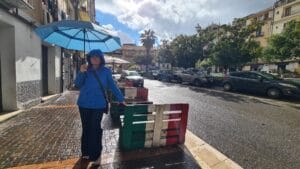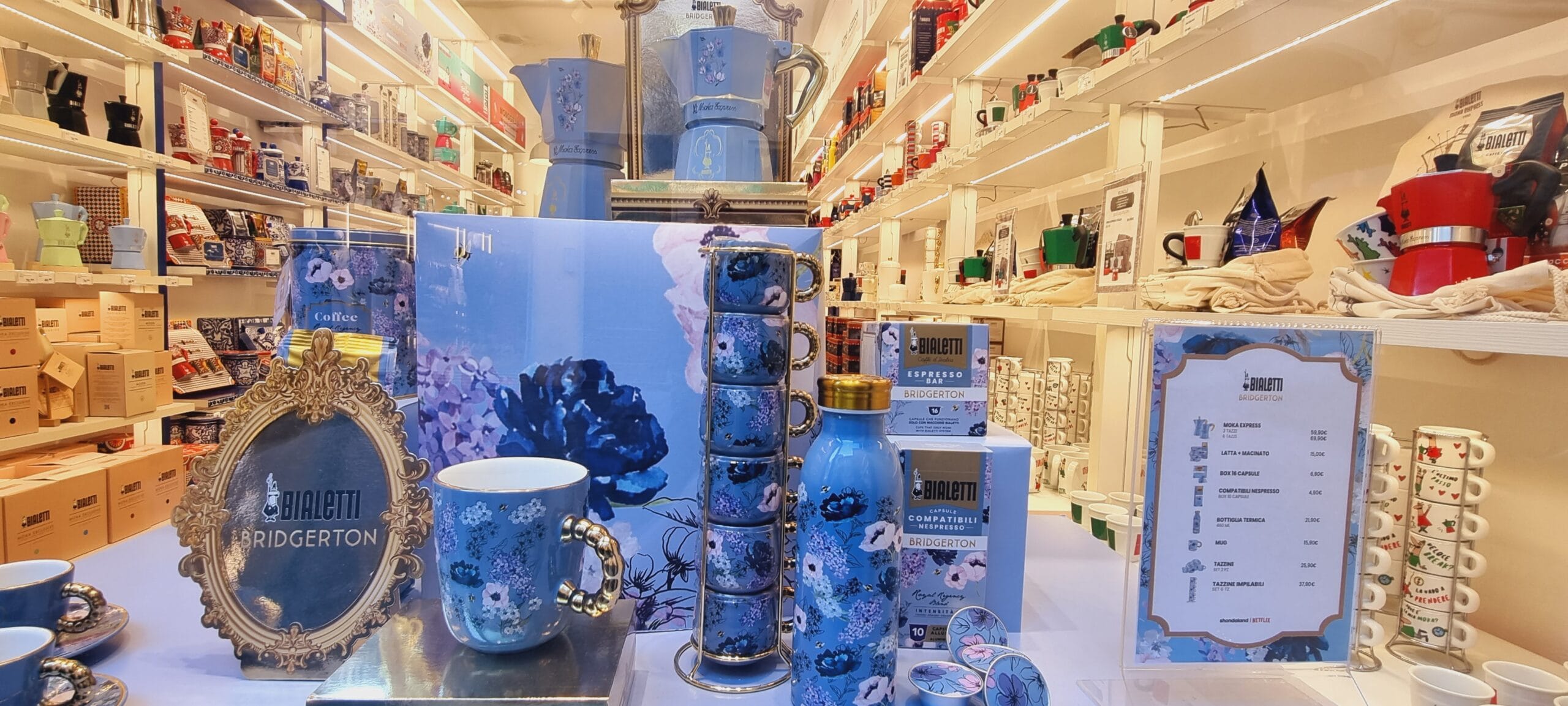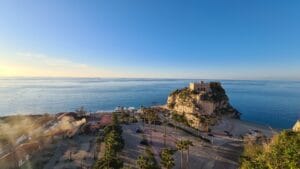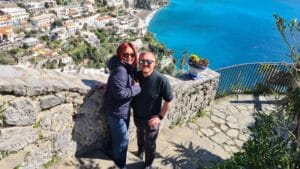
Lamezia Terme: The Blog That Nearly Didn’t Happen – By Andy
A2Z Wander | Our Blog A Rainy Arrival (and a Slight Hangover) Lamezia Terme almost didn’t get its own blog post. There’s only so many

“Is two hours enough in Pisa?” – One of the most commonly asked Google travel searches. Well, if you only visit the Leaning Tower, snap a photo of yourself ‘holding it up’, and then leave, you might think so. And that’s exactly how the city has earned its somewhat unfair reputation as a one-hit wonder. But Pisa deserves better.
It’s like visiting London, glancing at Buckingham Palace, and deciding you’ve ‘done’ the whole city. Madness!
We arrived in Pisa with an open mind and, admittedly, only half a day to spare. But when you’ve got 35 travel days ahead of you, you learn to embrace the journey itself – even the so-called ‘travel days’. Instead of rushing through, we decided to make the most of it.
Our day started at 9 AM with a stop at the incredibly convenient luggage storage inside the station – €5 per bag, no matter the size, all day. Manned by an actual human (a rare sight these days), no awkward locker wrangling, just a quick ID check, a receipt in hand, and we were free. Smooth, painless, and oddly satisfying.
Feeling lighter (literally!) and full of optimism, we did what any self-respecting traveller in Italy does first: we went for coffee. A quick espresso stop to fuel the adventure, and then we set off on the 20-minute walk to the tower, ready to see what Pisa had to offer beyond the cliché.
Pisa often gets unfairly compared to its glitzier neighbours. Overshadowed by Florence’s grandeur and the rolling hills of the Tuscan countryside, it doesn’t boast a long list of ‘must-see’ attractions. But that’s exactly why it’s worth visiting.
It’s a city that invites you to slow down, to take it all in without the pressure of a never-ending itinerary. Pisa isn’t about ticking boxes—it’s about wandering, discovering, and simply being.

 Away from the tower, Pisa has a distinctly local feel. It’s an authentic Tuscan city, unbothered by its international fame. Walking from the station, we passed old buildings with weathered facades, crumbling archways, and shutters that had seen better days.
Away from the tower, Pisa has a distinctly local feel. It’s an authentic Tuscan city, unbothered by its international fame. Walking from the station, we passed old buildings with weathered facades, crumbling archways, and shutters that had seen better days.
Unlike other places we’d visited on this trip, there was no sign of freshening up for the tourist season—no new paint, no attempt to impress. Pisa just is, and there’s something refreshingly honest about that.
One thing Pisa does do exceptionally well? Food. Everywhere we turned, there were inviting cafés, local bars, and restaurants tucked into quiet corners. Every turn revealed something tempting—trays of golden cantucci (Tuscan biscotti) waiting to be dunked into a glass of vin santo, and steaming plates of pici pasta.

We found ourselves stopping every few minutes, drawn in by hand-written menus (away from the tower blissfully free of tourist-friendly photos!) and the smell of fresh pasta drifting from tiny kitchens. Pisa is a reminder that the best meals aren’t always found in the prettiest places—sometimes, they’re just around the next corner, waiting to be stumbled upon.
That’s exactly how we stumbled upon Ristorante e Enoteca Grano Libero (Free Grain)—a gluten-free restaurant with a focus on innovation and inclusivity. Their philosophy? Food should unite, not separate. And wow, they nailed it.
We started with a vegetarian platter, and honestly, it could have been lunch on its own. A beautifully arranged selection of courgette buns, pumpkin hummus, bruschetta, and leek flan—each bite packed with flavour and perfectly executed.

Then came the pappardelle with wild boar ragu, which we shared alongside some grilled vegetables. The pasta? Perfectly al dente. The ragu? Clearly simmered for hours, its tomatoes rich and sweet, the meat so tender it melted with every bite.

By the time we left, we had those silly, happy food faces that only a truly great meal can bring. It felt like we’d uncovered a real find—one of those places you immediately want to tell people about, but also kind of want to keep as your own little secret.
One of the best things about Pisa? It’s refreshingly affordable. Unlike its glitzy neighbour Florence, where a spritz can cost as much as a small meal, Pisa remains kind to your wallet. A cappuccino won’t set you back a fortune, a plate of pasta is still reasonably priced. It’s a city that still feels lived-in rather than curated for tourists, and that’s part of its charm.
Of course, we couldn’t not visit the Leaning Tower. In 2023, it marked its 50th anniversary since reopening after extensive stabilisation work. Once tipping at a perilous 5.5 degrees, careful engineering has nudged it back to a (relatively) safer 3.97-degree slant.
 It’s a textbook case of what happens when you build on unstable ground—an architectural blunder that, by sheer luck, became one of the world’s most famous landmarks. But the tower is only part of the Piazza dei Miracoli (Square of Miracles), a UNESCO-listed complex that includes the stunning Duomo, the Baptistery, and the Camposanto (cemetery). If you only come for the tower, you’re missing half the magic.
It’s a textbook case of what happens when you build on unstable ground—an architectural blunder that, by sheer luck, became one of the world’s most famous landmarks. But the tower is only part of the Piazza dei Miracoli (Square of Miracles), a UNESCO-listed complex that includes the stunning Duomo, the Baptistery, and the Camposanto (cemetery). If you only come for the tower, you’re missing half the magic.
The enormous Square of Miracles is simply stunning. Gleaming white marble from the foot of nearby Mount Pisano makes you reach for sunglasses even on an overcast day. The first ‘miracle’ to be built was the cathedral (1064), followed by the Baptistery in 1152. Then Leaning Tower (1173), the Spedale Nuovo (1257), and finally the Camposanto Monumentale (1277) on the north side.

We chose to visit the Baptistery, which includes a ticket for the Duomo, great value at 8 euros per person. The baptistery was built to complement the cathedral, its size, materials and style were designed in harmony with the majestic building already standing opposite.

With a circumference of 107.24 metres, walls 2.63 metres thick at the base, and a height of 54.86 metres, it is the largest baptistery in Italy. Like the cathedral, it’s built with striking white and grey striped marble. The double dome feature provides exceptional acoustics – apparently every 30 minutes the staff member on duty sings a few words to demonstrate this to the public. We must have visited between demos but it’s easy to imagine how such a feature could produce incredible sounds.
While most tourists flock straight to the Leaning Tower, Pisa’s Piazza dei Cavalieri (Knights’ Square) is an underrated gem.

Once the political heart of the city and later home to the Knights of St. Stephen, it’s lined with grand Renaissance buildings, including the ornate Palazzo della Carovana, designed by none other than Vasari, the renowned Florentine artist and architect, and responsible for the Vasari corridor at the Uffizi gallery.
Today, it’s part of Pisa’s university district, giving it a lively student buzz.
If you want to escape the crowds, head to the banks of the Arno River.
Pisa was once a powerful maritime republic, rivalling the likes of Genoa and Venice, and while those days are long gone, the river still tells the story of its seafaring past.
The picturesque bridges, including the Ponte di Solferino—a ‘moving’ bridge that shifts ever so slightly with the current so it feels like it’s moving! It’s a fascinating little quirk, adding to Pisa’s unexpected charms.

Few people realise that Tuscany is the birthplace of one of the most famous fictional characters in the world—Pinocchio. His creator, Carlo Collodi, spent much of his life in the region, and Pisa pays homage to him with charming bookshops and small exhibitions that celebrate the wooden puppet’s legacy.
Beyond its literary connections, Pisa also holds centuries of history in its very foundations—quite literally.
For a different perspective of Pisa, you can climb the well-preserved Medieval City Walls. Dating back to 1156, they offer panoramic views of the Piazza dei Miracoli and beyond. And if you need a break from sightseeing, the Orto Botanico—one of the oldest botanical gardens in the world—is a peaceful retreat.
Founded in 1544, it’s home to rare plants, ancient trees, and a collection of medicinal herbs that have been cultivated for centuries. We didn’t have time to explore these but it’s another reason why we should have allowed more time for Pisa.
Pisa might not be a shopping mecca, but it has its charms. Along Borgo Stretto, you’ll find a mix of boutique stores, family-run shops, and stylish Italian brands. It’s the kind of place where you can pick up a quality leather bag without the Florence price tag.

One of the best things about Pisa? It’s walkable. You can see most of the main sights in a day without the need for taxis or public transport. It’s compact, flat, and easy to navigate—perfect for wandering at your own pace.
If you only visit Pisa expecting a grand, polished city, you might be disappointed. But if you come with an open mind, ready to embrace its slightly worn façades, and its unpretentious charm, you’ll find a city with layers of history waiting to be uncovered.
After all, this is the birthplace of Galileo, a city that once stood shoulder to shoulder with Venice and Genoa as a mighty maritime republic. Today, Pisa doesn’t try to impress—it just is. And that’s precisely why it’s worth visiting.
And as we made our way back to collect our bags, we realised Pisa had done something no guidebook had prepared us for—it had surprised us. Beyond the famous tower, beyond the touristy myths, we found a city content in its own skin, one that rewards those who take the time to look beyond the obvious.
Would we come back? Absolutely. Not for the tower, but for the atmosphere, the food, and the feeling that sometimes, the best travel experiences aren’t about checking off sights but about simply being there.

Follow us on instagram @a2z.wander

A2Z Wander | Our Blog A Rainy Arrival (and a Slight Hangover) Lamezia Terme almost didn’t get its own blog post. There’s only so many

A2Z Wander | Our Blog A short coastal train ride punctuated by dramatic thunderclaps brought us further down into Calabria to a town called Scilla.

A2Z Wander | Our Blog This is quite the introduction to the town of Tropea… This is the view from Belvedere Piazza del Cannone in

A2Z Wander | Our Blog Three weeks into the trip, and we were finally swapping wheels for waves, boarding our first boat along the coast

A2Z Wander | Our Blog With Sorrento in our rear-view mirror and the sea glittering to our right, we eased into the Amalfi Coast Drive,

A2Z Wander | Our Blog Naples left its indelible mark on us. We were sad to be leaving with so much still unexplored. But, if